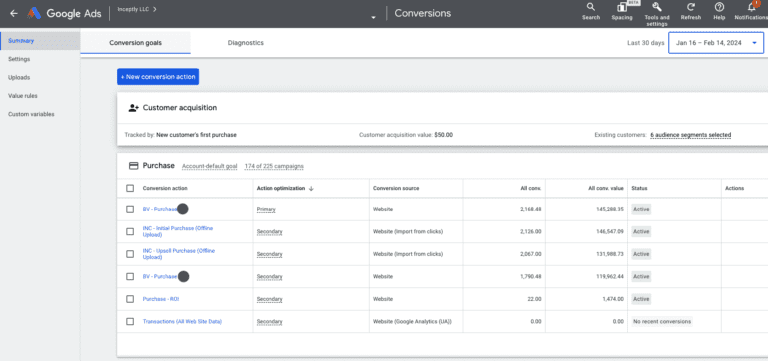
Ever wonder why some conversions slip through the cracks, despite your best efforts?
Understanding the distinct flavors of website, offline, and GA4 conversions isn’t just a part of the job—it’s the linchpin in crafting strategies that actually move the needle.
Here’s the raw truth: many marketers are shooting in the dark, using fragmented insights to inform their strategies. The result? Missed opportunities and wasted budgets. But it doesn’t have to be this way.
We’re diving straight into the mechanics of each conversion type, shedding light on how to stitch these disparate pieces into a coherent strategy. From leveraging the immediate feedback of website interactions to untapping the hidden value of offline engagements and exploiting the depth of GA4 analytics, we’re all about turning overlooked data into your most potent weapon.
Want to brainstorm with our team on new ways to scale your business with YouTube Ads (and other performance video platforms)?
Join us for a free YouTube ad brainstorming session:
Let’s deep dive…
Website conversions
A conversion on your website occurs when a visitor takes a key action—like purchasing, signing up, or filling out a form—marking a direct impact on your business success. What is the beauty of digital tracking? These conversions offer near real-time insights, allowing you to quickly gauge the effectiveness of your website and marketing strategies, and adjust on the fly to improve performance.
Let’s break down two key players: Google Tag Manager (GTM) and Global Site Tag (gtag.js), and how they differentiate in empowering your marketing strategies.
Google tag manager (GTM): GTM acts as a command center for your site’s tags, enabling you to quickly add and update tracking codes for conversions, analytics, and more without needing to edit your site’s code. It’s all about flexibility and efficiency, simplifying tag management so you can focus on optimizing your campaigns.
Global site tag (gtag.js): While GTM orchestrates your tag management, gtag.js provides a unified, streamlined scripting framework for your site, ensuring reliable data collection and sharing across Google’s platforms like Analytics and Ads. It’s the foundation for accurate, comprehensive tracking, enhancing your ability to understand and act on user behavior.
Together, GTM and gtag.js offer a powerful duo to capture the pulse of your website activity in real-time, each with its unique role in streamlining your data collection and analysis for sharper, more effective marketing decisions.
GA4 conversions

GA4 reimagines conversion tracking, making it more adaptable and insightful for today’s cross-platform, multi-device digital landscape.
Here’s a straightforward breakdown of what GA4 conversions bring to the table:
Flexibility in conversion definition: GA4 allows you to designate virtually any user action as a conversion. This means you can track a broader spectrum of meaningful interactions, from page views and app installs to video engagements, tailoring your analytics to your unique business goals.
Event-based tracking model: Unlike traditional models that focus on page views, GA4 tracks user interactions as events. This provides a granular view of user behavior, enabling you to identify and measure the specific actions that contribute to your success.
Cross-platform user insights: GA4 excels in tracking user journeys across websites, apps, and other digital platforms. This unified approach offers a comprehensive view of how users engage with your brand, enabling more informed, strategic decisions.
Embracing GA4’s conversion tracking empowers you to leverage detailed, action-based insights and cross-platform data, setting the stage for more effective marketing strategies and enhanced business outcomes.
Offline conversions
Marketers harness platforms like Hyros and Wicked Reports, alongside custom backend tracking, to bridge the gap between online campaigns and real-world outcomes. These tools capture a wide range of actions, from phone calls to lead submissions and purchases, providing invaluable insights into customer engagement beyond digital channels.
Capturing real-world interactions: These platforms track a variety of offline interactions, offering insights into how customers engage with your brand.
Integration with marketing platforms: Offline conversions are seamlessly imported into marketing platforms, enriching datasets and enabling accurate attribution of conversions to campaigns.
Precision and accuracy: While not real-time, offline conversions provide precise and accurate insights, empowering marketers to make data-driven decisions based on reliable customer behavior data.
These tools play a vital role in enhancing the understanding of campaign effectiveness and optimizing strategies to drive tangible business results.
Let’s summarize this
In conclusion, leveraging website, offline, and GA4 conversions in marketing channels offers marketers a comprehensive view of customer engagement across online and offline touchpoints. While each type of conversion has its strengths and weaknesses, combining them provides a holistic understanding of campaign performance and customer behavior.
While website conversions keep you plugged into the digital pulse, offline conversions ground your campaigns in real-world impact, and GA4 conversions serve as the all-seeing eye across platforms. The key lies in utilizing the strengths of each type of conversion to optimize marketing strategies effectively.
Website conversions excel in immediate feedback and online tracking, while offline conversions bridge the gap between online campaigns and real-world outcomes. GA4 conversions offer cross-platform insights, enhancing the understanding of the customer journey.
By integrating all three types of conversions, marketers can refine targeting, measure campaign effectiveness accurately, and ultimately drive better results. The best approach involves leveraging the unique benefits of each type of conversion to create a comprehensive and data-driven marketing strategy that maximizes ROI and delivers impactful results.
Want more content like this?
Don’t miss out on the latest news and updates from the world of Direct Response advertising! Subscribe to our newsletter today 👇

Maksim Miceta, Data Scientist
Hailing from the world of science, Maksim excels at making sense of data. His superpower is extracting valuable insights that allow us to optimize media spend and the effectiveness of ad campaigns.
Want to brainstorm with us on new ways to scale your business with YouTube Ads (and other performance video platforms)?
Book a free YouTube ad brainstorming session with us here: 👇
Like this post? Let's continue the conversation!
Get in touch with us by shooting us a quick email or tagging us on LinkedIn or Instagram, and sharing your thoughts. Your feedback helps us keep our blog relevant and interesting.
Get Our Newsletter
Need Help?
Get in touch with us for an insightful evaluation of your ads + actionable tips to help amp up your direct response revenue



